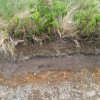I found these exposed soil layers, quite interesting, 3 layers, current brown layer divided by a small black line, I suppose from the burning of the land, then a very dark brown gray layer and then a sandy gravelly layer. The gravel at the bottom is just the accumulation that falls out of the face

My thoughts where the different land uses over time, grass woodland and glacial.?

My thoughts where the different land uses over time, grass woodland and glacial.?

